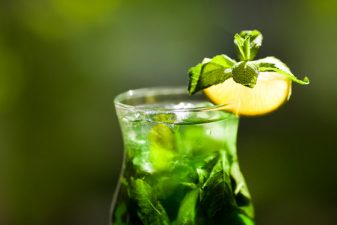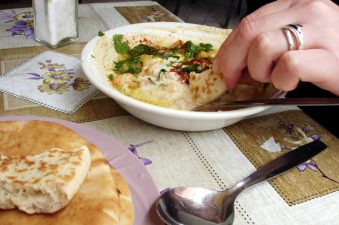A Middle Eastern flavor that refuses to go out of style – sheep’s tail fat.
Some vegetable species thrive in harsh, arid conditions and still produce oil, like argan trees. And some animal species survive the desert by storing fat around their bodies, like camels. And like Awassi sheep, bred to store fat in their tails. A mature ram’s tail can carry up to 12 kg. (25 lbs) of prized fat, softer and more delicately-flavored than fat stored in the body’s interior.
Cooking with alya, the rendered fat, has been around for a very long time. The oldest existing Arabic cookbooks (both called Kitab al-Tabikh and written between the 10th and 13th centuries) instruct the cook to “melt tail fat.” A 6th-century mosaic from the Beit Alpha synagogue, Israel, depicts shepherds and a fat-tailed sheep.
Nowadays vegetable oils are preferred in daily Middle-Eastern cooking, yet when folks crave that old-time flavor, it’s still fat rendered from sheep’s tails. In rural areas, people simply heat chunks of it to melt down in the skillet or pot, as done with chicken shmaltz or bacon. Townsfolk can find white disks of prepared rendered sheep’s fat in the freezers of their supermarkets. In Israel, it’s even kosher.
Some skewer and grill whole chunks of the fat, declaring that the delicious flavor is worth any health risk. I have eaten potatoes flavored with lamb fat in a high-end Jerusalem ethnic restaurant. A stack of shwarma meat is often topped with a slab of fat to drip down as the meat rotates and cooks; shish kebabs may alternate chunks of lamb cubes and fat with onions and other vegetables.
 Festive Asian/Russian rice dishes like the Bucharian osh polo and Uzbeki plov pilaf start by frying meat in lamb fat. In rural Lebanon, lamb meat is traditionally preserved in the fat, confit-style, and called qawarma.
Festive Asian/Russian rice dishes like the Bucharian osh polo and Uzbeki plov pilaf start by frying meat in lamb fat. In rural Lebanon, lamb meat is traditionally preserved in the fat, confit-style, and called qawarma.
According to traditional Arabic medicine, drinking warm, liquid alya will cure sciatic pain if taken three days in a row.
Feel like trying it out?* If you’re not in the Middle East, maybe a Turkish or Lebanese butcher near you will spare you some lamb’s fat. Melt a couple of 1-inch cubes down slowly to use as the fat in a rice dish, fishing out the cracklings to salt and eat quietly as the cook’s treat. Or chop up any quantity of raw fat, , cover it with cold water, and put on a medium heat. When the water has evaporated and the meat adhering to the fat starts to pop and crackle, allow the liquid fat to cool down to warm. Strain it into a jar. Let it cool, and store in the fridge for up to 6 months.
What can you do with the fat? Same as you would with lard, shmaltz, or drippings from a roast. Fry eggs in it, spread a little on bread if you dare, cook some into almost any vegetable or meat dish. Substitute it for the olive oil in our maklubah recipe. I’ve heard that a discreet quantity of rendered sheep’s tail fat is the secret of really spectacular baklawa – but if that’s so, the bakers aren’t giving the recipe away.
More Middle Eastern lamb recipes from Green Prophet:
Photo of Assawi sheep by Fardeen Omidwar via Sheep 101
Photo of lamb shish kebabs by Mamonello via Flickr.





